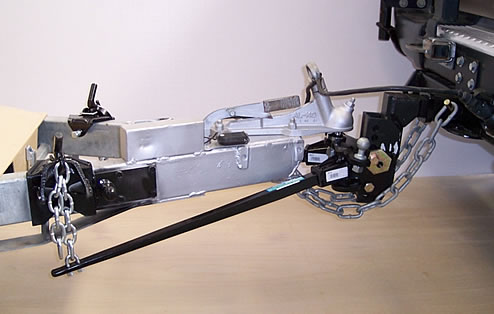If the weight of your trailer is causing the rear end of the tow vehicle to sag, you might need to attach a weight distribution hitch.
Normally, the weight is transferred and carried at the tow ball. A weight distribution hitch fits onto the draw bar of the trailer to evenly distribute weight across all axles of the towing vehicle and trailer.
This will result in a more level ride with more control and stability, better braking, less strain on the vehicle and increased towing capacity.
Hitches vary for different towball weights. We’re going to look at how to connect a heavy-duty weight distribution hitch for loads over 130kg.
Preliminary steps
The first thing to do is ascertain the trailer’s tow ball weight. This will determine the weight distribution hitch needed.
Make sure the towing vehicle has the correct receiver hitch. Levellers for loads up to 130kg can be attached using a cast-iron head fitted under the tow ball, however heavier loads require a strong, professionally fitted receiver hitch on the tow vehicle.
Connecting the weight distribution hitch
- Park the towing vehicle and caravan on a flat surface, but do not connect just yet.
- Measure the distance between the ground and the front wheel arch of the towing vehicle, for reference when checking the settings later.
- Ensure the tow ball is set at the right height; if not, adjust the bolts in the receiver hitch.
- Connect the ball coupling securely and lower the jockey wheel.
- Clamp the load brackets in place on the trailer’s A-frame in a position so that the chains will be vertical when connected.
- Insert the ‘T’ end of the spring arm into the receiver hitch and turn until it locks into position.
- Open the hinged part of the load bracket and select a link of chain to connect onto the hook on the bracket.
- Close the bracket, using a lever or pipe if necessary, to put tension on the chain and lift the spring arm into place.
- Secure with the locking pin and repeat on the other side.
- Measure the height of the wheel arch(es) again to check the towing vehicle is closer to being level.
If necessary, repeat steps 7–10 using a different chain link each time until the front wheel arch is at its optimum height, thus ensuring traction on the road.
To avoid injury, keep feet well clear of the bars when securing or releasing them. Reducing tension on the bars by having the jockey wheel in place will also help prevent the likelihood of injury.
Weight distribution hitches offer a distinct advantage but should be used in accordance with the recommendations of your dealer.
Learn more about weight distribution hitches and why you should use one on your trailer.
Article image courtesy of Hardings Swift Caravan Services





